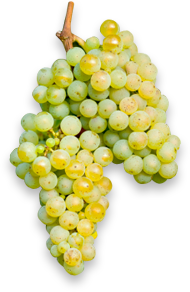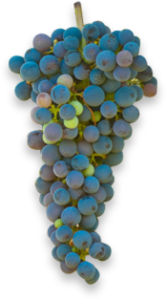Varieties

Introduction
Grape varieties not only have their own characteristics, conferring various tastes to the wines, but they do differ on each soil they grow on. Simple as mixing ingredients in a cocktail, winemakers tend to assemble the right grapes, on the right soil, in the right proportion to achieve the perfect balance in colour, tannins, acidity and flavours.
red wine grapes
cabernet sauvignon
- Dominant in Medoc and left bank of Gironde
- Small berries with thick and dark skins
- Wines produced are deep coloured and high in tannins
- Aromas of black fruits (plums, blackcurrant), spice, cigar box
merlot
- Dominant in Saint-Emilion and right bank of Gironde
- Early ripening and maturing grapes
- Wines produced are less tannic than Cabernet Sauvignon
- Aromas of red berries, cherries
cabernet franc
- Dominant in the right bank of Gironde
- Low in tannin and acidity because of thin skin
- Aromas of raspberry, violet, tobacco
white wine grapes

- Dominant grape variety in production of dry white Bordeaux
- Also used in Sauternes
- Aromas of citrus, freshly cut grass, grapefruit
semillon
- Dominant in sweet white wines in Sauternes and Barsac
- Thin-skinned grapes reactive to noble rot (botrytis cinerea)
- Noble rot concentrates sugar in the grapes
- Aromas are honeyed and colour varies from deep gold to brownish
muscadelle
- Small proportion used in sweet wines (5%)
- Brings some freshness to the wines
champagne grape varieties

chardonnay
- Aromas of citrus, grapefruit, very floral
- Blanc de Blancs is made from 100% Chardonnay
- Brings complexity and help long maturity in a Champagne blend
pinot noir
- In a Champagne blend, it gives structure and body
- Aromas of red berries and cherries
pinot meunier
- Rare outside Champagne
- Brings acidity and fruit aromas
- Helps long ageing in blends
Introduction
Grape varieties not only have their own characteristics, conferring various tastes to the wines, but they do differ on each soil they grow on. Simple as mixing ingredients in a cocktail, winemakers tend to assemble the right grapes, on the right soil, in the right proportion to achieve the perfect balance in colour, tannins, acidity and flavours.
red wine grapes
cabernet sauvignon
- Dominant in Medoc and left bank of Gironde
- Small berries with thick and dark skins
- Wines produced are deep coloured and high in tannins
- Aromas of black fruits (plums, blackcurrant), spice, cigar box
merlot
- Dominant in Saint-Emilion and right bank of Gironde
- Early ripening and maturing grapes
- Wines produced are less tannic than Cabernet Sauvignon
- Aromas of red berries, cherries
cabernet franc
- Dominant in the right bank of Gironde
- Low in tannin and acidity because of thin skin
- Aromas of raspberry, violet, tobacco
white wine grapes

- Dominant grape variety in production of dry white Bordeaux
- Also used in Sauternes
- Aromas of citrus, freshly cut grass, grapefruit
semillon
- Dominant in sweet white wines in Sauternes and Barsac
- Thin-skinned grapes reactive to noble rot (botrytis cinerea)
- Noble rot concentrates sugar in the grapes
- Aromas are honeyed and colour varies from deep gold to brownish
muscadelle
- Small proportion used in sweet wines (5%)
- Brings some freshness to the wines
champagne grape varieties

chardonnay
- Aromas of citrus, grapefruit, very floral
- Blanc de Blancs is made from 100% Chardonnay
- Brings complexity and help long maturity in a Champagne blend
pinot noir
- In a Champagne blend, it gives structure and body
- Aromas of red berries and cherries
pinot meunier
- Rare outside Champagne
- Brings acidity and fruit aromas
- Helps long ageing in blends

